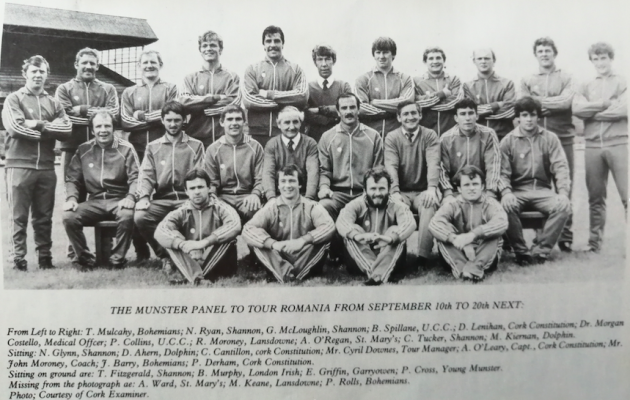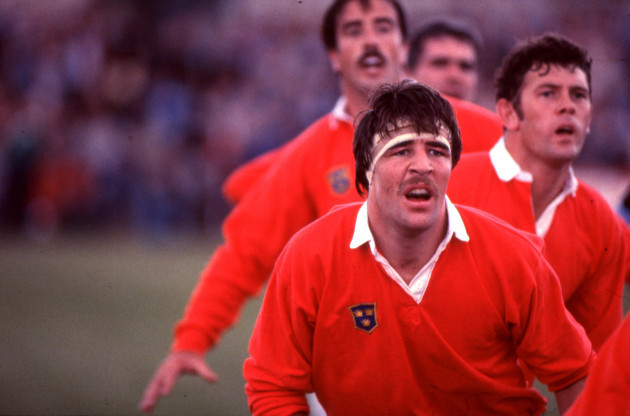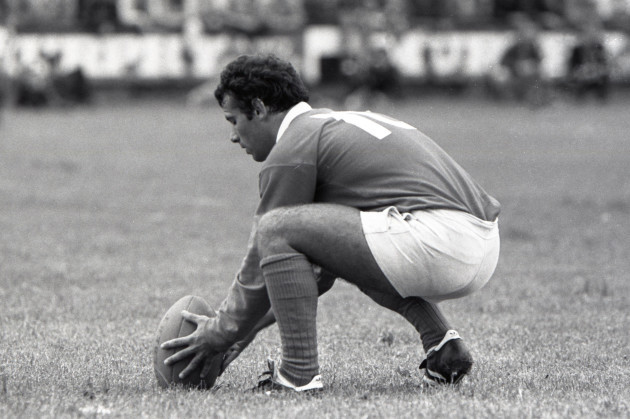Dark.
Almost 40 years later, that’s the first word that comes to mind when Donal Lenihan thinks back to Munster’s 1982 tour of Romania.
“I remember we played our first match in Iasi, about 12 miles from the Russian border,” Lenihan says.
“Iasi was like travelling through a time tunnel and being thrown back to the 1930s. The only cars they had there were black. It suited the mood of the area. Ireland in the 1980s wasn’t exactly the centre-point of the world, but Jesus, we didn’t feel too bad after Romania.”
“I remember vividly the shock we got when we arrived up there,” says Tony Ward. “You know you hear about how in communist regimes you’re all equal? Well these people were all equally poor. There were queues of people literally starving, queueing for food and hand-outs.”
In September 1982, Munster became the third Irish team in an 18-month period to step behind the Iron Curtain, following a roadmap travelled by Leinster and Ulster before them.
As soon as they landed, a sense of unease had engulfed the squad.
- For more great storytelling and analysis from our award-winning journalists, join the club at The42 Membership today. Click here to find out more >
“Without getting overly philosophical – I’m one of these sensitive beings,” says Ward. “After the Lions tour to South Africa in 1980, I didn’t go back with Ireland in ’81 because my social conscience had been really pricked.
Romania did that to me as well. It really exercised my social conscience because we all got a shock when we got out there and saw the reality of life. There were certain things we were told to bring with us to leave as gifts, like second-hand denims, ladies tights, which sounds ridiculous but they couldn’t get them. There were no shops as such because the local currency was worth nothing in global terms.
“You always came back from tours with your bags bulging with souvenirs and different things, but I hardly came back with anything in my bag from Romania. I gave away all my gear and that to the players we were playing against because they just didn’t have it over there, it was just so tough on them at the time.”
Under the communist regime of Nicolae Ceausescu, the people starved while the rugby flourished.
The sport’s roots in the country could be traced back to the early 20th century, with Bucharest students returning from Paris and British workers based in the oilfields both taking credit for introducing the game to this new audience. Interest in the sport grew rapidly. A Romanian team collected bronze medals for Rugby Union at the 1924 Paris Olympics, being one of only three nations to compete in the sport, alongside France and gold medal winners, the USA.
Ceausescu, who came to power in the mid-60s, had a fondness for rugby and used it as a propaganda tool, pumping in the necessary funds and pushing a gifted Romanian national team onto the international stage. Backboned by men who served in the defence forces, Romania’s players were essentially semi-professionals during the amatuer era, with CSA Steaua Bucuresti, founded by the army, and Dynamo Bucuresti, representing the police force, emerging as the country’s two prominent teams.
By the time Munster landed in the autumn of ’82, Romanian rugby was in the middle of a golden era.
The country had won their last three games against France – a country which continued to heavily influence the game in Romania – and regularly put 30 or more points on Italy. They drew with Ireland at Lansdowne Road in 1980, and beat Munster, Ulster on Connacht during the same trip. A month later, a 15-0 win over France led to the Home Nations agreeing to award Test caps for games against Romania. Their fine form would carry into the decade, beating Wales (1983) and a Grand Slam-winning Scotland team (1984), while two disallowed tries denied them a famous result against the All Blacks (1981).
“They were exceptional,” Ward says. “That was the height of Romanian rugby, and because Romanian rugby was very much based on the French model, they were very talented players too. They used the ball well, it wasn’t just power and fitness by any means.
“Mircea Paraschiv, the scrum-half and captain, I got to know him quite well on the ’80 tour. And one of the second rows, Gheorghe Dumitru, and Enciu Stroika (flanker), there were a few of them who were big names at the time.”
“In many respects, we were the amateurs (on that tour) ,” adds Lenihan. “All the guys we were playing against were either in the army or in the police, so in effect they were almost semi-professional because they were cherry-picked by the regime.”
There was a growing sense Romania would soon enter the Five Nations. Inviting touring squads to the country was an opportunity to show they could not only host the best teams in Europe, but provide stern competition, too.
And so, following Romania’s 1980 tour to Ireland, the provinces took turns making the journey across Europe. Munster’s trip started with a night in Bucharest.
“You could see that this was different, you had big open squares. There was a suspicion the phones were being tapped, especially in Iasi,” Lenihan says.
“I do remember, everywhere you went there were people around in the background, and we were warned about that beforehand,” Ward adds. “We didn’t really go out and about. We were definitely very aware that there were people in the background and that they were government agents or whatever.”
The team hotel provided the touring group with an early indication of the limitations of life in a country which had been gripped by communism for 35 years. Yet even in the those bleak circumstances, memories were forged which still raise a smile.
“Before Iasi, we were all complaining because the only thing you could get to eat was a bit of pork on a plate, nothing with it, and an apple. That was your dinner,” Ward says.
“We had heard all these horror stories about the food and loads of fellas had got sick with food poisoning,” Lenihan continues.
“But there was five or six Shannon fellas on the trip and we couldn’t understand how over the first few days, they were the only fellas not getting sick. They used to disappear around five o’clock every evening and we got suspicious after a while, so sent a delegation up to their room.”
Ward continues, “The reserve hooker on that tour was Noellie Glynn from Shannon. The Glynns were butchers in Limerick on Patrick Street. Colm Tucker had got word that things were rough in Romania, so Colm got Noellie to vacuum pack a load of meat – very advanced technology to us at the time – and bring it out with him. Most evenings the Shannon lads would disappear after the meal, and go off and have their own dinner.”
“Tucker had given this big speech about how we were all in this thing together,” Lenihan laughs, “I have great time for Colm, but he’d organised the whole feckin’ thing!”
For the opening game on 12 September, Munster boarded a plane bound for the border town of Iasi, deep within the Iron Curtain. They just about managed to bring Moss Keane with them.
“Mossie was a shocking flyer,” Lenihan explains, “and we were getting on one of these old propeller planes where you literally walked out to the runway and put your bag into the boot of the plane yourself.
I can remember the steel rims being visible on the tyres. Mossie nearly had a heart attack when he saw that, and started complained. Next thing this fella in overalls came over – it was like being at some garage down in West Cork – he had a screwdriver with a big wooden handle and started beating the tyre – ‘It passed the test, it’s ok.’
“So we climbed onto the plane, blessed ourselves, I think we might have even sang. Thankfully, we survived.”
Munster’s opponents, Polytechnica – a largely student-based side – brought in some outside help to form what was billed as a Moldova provincial team.
Posters in Iasi advertised the visit of ‘The only team to beat the All Blacks’, but shaken by their early impressions of the country and two long days of travel, Munster laboured to an 18-12 win in intense sunshine. Keane told reporters he hadn’t experienced such heat “since the last time I was in Kerry.”
Next up was a trip south to the resort town of Constanta on the Black Sea, where in a far more relaxed setting, Munster’s players walked the beaches, visited a bowling alley, and began to enjoy the rare opportunity to spent time together as a squad.
“We played Farul Constanta, and I’d say it was one of the dirtiest games I ever played in my life,” Lenihan remembers.
Munster’s cause wasn’t helped by a ferocious home crowd, who found an early pantomime villain in the shape of Keane, who had been permitted a couple of days off between the first and third games.
“I can still see him,” Ward laughs. “He wore his white shorts, his Lansdowne socks, a grubby auld training jersey he had with him, and was the official touch judge representing Munster.
“I remember at one stage Wardy kicking a ball out on the full, and Mossie striding up the sideline and putting up the flag when clearly the ball had gone straight into touch,” Lenihan continues.
“The crowd were going bananas and throwing things at him. The Incredible Hulk was the big thing on television, and so Mossie turned around and did this impression your man turning into the Hulk.”
Ward: “I can still see the crowd roaring abuse at him.”
Lenihan: “Because Mossie was rested, Brian Spillane played second row. Spillane was a top-of-the-ground, free running feckin’ artisan. The grind and the dirty games wouldn’t have been his palate.
“There was an article in the programme about Moss and myself being the Irish second rows and winning the Five Nations and Triple Crown that year – I only knew it was about us by the pictures, none of it was in English.
“Farul had this one second row who was about 6’7″ and another fella who was about 6’2″, who kept following me around everywhere I jumped in the lineout, so I was cleaning up.
“Spillane was cracking up because the 6’7″ fella kept following him. He eventually turned around to him and goes ‘I’m not Lenihan, he’s Lenihan!’ – and I’m shouting ‘Spillane, shut your fucking mouth and get on with it!”
Lenihian won six of the first seven lineouts before Farul put the pieces together and took control. Ward shipped a couple of early knocks and kicked Munster’s only points against a Farul side which contained a handful of international players, star centre Adrian Lungu causing the most damage in a 19-6 win which if anything, was kind to the tourists.
That night, the post-match function found itself merge into a Romanian wedding reception, where the need to dilute the local wine got lost in translation. More than a little worse for wear, the Munster squad dragged themselves onto the team bus to head back to Bucharest the next morning.
The third, and final game of Munster’s 10-day tour would see the province take on a Romanian national selection – essentially the Romania first team given the side included 14 internationals.
Described as one of Munster’s best performances for some time, the exceptional Michael Kiernan – who ran riot along the right wing – ended up providing the moment which turned the game on its head. After embarking on another blistering solo run with two minutes to play, Kiernan slipped at the vital juncture, turned the ball over, and Romania went down the field to score the game’s decisive try, winning 19-8.
While disappointed with their overall return, Munster were emboldened by both the manner of their performances, and the rare experiences shared.
Lenihan had missed the final game after taking an early flight home to attend his own wedding. Yet in the eyes of a young second row with big ambitions, a half-tour was better than no tour.
“A serious, serious, mistake,” Lenihan says of his early departure, “because I remember we had a court session and the torture I went through for ‘deserting’ the tour early.
Romania was no jolly from a rugby point of view… But see, the thing with Munster in those days was we only played a couple of matches a year. The Cork and the Limerick clubs were always baiting the shite out of each other and you didn’t have the same level of (togetherness). We were never at our best in the interpro series, but if a tour came, by Jesus, we just felt duty bound to pull together and perform because that was our heritage and our legacy.”
They travelled home chilled by what they saw of everyday life in Romania, but impressed by the status and grassroots support the game of rugby held in the country. Ward remembers feeling “certain” Romania would soon join the Five Nations.
Instead, the country entered a period of turmoil. After more than two decades in power, Ceausescu’s regime came under increasing pressure. A failed coup in 1984 was followed by a successful revolution in 1989.
In the years between, the Romanian team continued to tour, a shadow of their former selves.
“The whole thing fell apart very quickly there,” Lenihan says. “In ’86, we played Romania in Lansdowne Road, and beat them 60-0, which was unheard of international rugby, no matter how bad the opposition were. [Ireland set new records that day for both the highest points total and winning margin in a full international]
“It was my first game as captain so I was at the top table for the function, and I remember the Romanian players were just dour, going around collecting anything loose in the place. They looked like fellas who hadn’t seen a meal for a long time.
“The fighting started just after that.”
Romania became increasingly unstable across the latter half of the decade. A handful of Romanian internationals, as well as a number of promising young players, would be shot and killed during the fighting, including Florica Murariu, a star of the 1987 World Cup and one of the outstanding flankers of his time, who was shot at a checkpoint during the final hours of the revolution.
Others were lucky enough to defect while on tour overseas.
“That’s how bad it was over there at the time,” Ward says. “We are talking about life and death, and putting food on tables.”
The revolution ended with the capture and arrest of Nicolae Ceausescu in December of 1989. On Christmas Day, Ceausescu was tried in court for charges including illegal gathering of wealth and genocide, and was sentenced to death. Ceausescu and his wife, Elena, were shot dead by machine gun fire that evening. Within hours, footage of the executions was being broadcast on Romanian television.
As the country began the slow process of rebuilding, state support was directed towards more pressing issues than rugby, and a slew of the country’s best players moved away in search of a better life. A memorable win against Fiji at the 1991 World Cup remains one of the last great days for Romanian rugby.
The Five Nations would eventually expand to Six when Italy joined in 2000. Romania are currently ranked 18th in the world, sandwiched between Uruguay and Spain.
“I’m not great for keeping my souvenirs,” Ward says. “I don’t believe in having jerseys in your drawers and I’ve given almost everything away over the years.
“But one thing I have kept, I have it in my hand here at the moment… I have this wooden spoon, which is appropriate in one way, that an ordinary guy had made out there. It has these markings on it, little designs, ‘Romania v Munster, 19 September‘, then he has myself, Mossie and Colm Tucker highlighted on the spoon part. On the back here is the 1982 tour, all the Bucharest team, Constanta team, then down the bottom, ‘Rugby world – Parc des Princes, Ravenhill, Murrayfield, Lansdowne Road‘… It’s just beautiful.
“I’ve kept it to this day, and it’s probably worthless, but it means an awful lot to me because of the person who gave it to me, the fanaticism of those Romanian people about rugby. It typified the game out there at the time.”
- For more great storytelling and analysis from our award-winning journalists, join the club at The42 Membership today. Click here to find out more >





